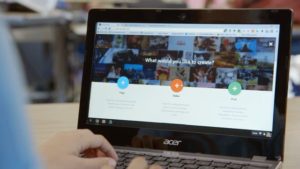
More than half of the educators that don’t have access to creative problem-solving tools list school budgets as a reason — so Adobe is giving away student software for free. Beginning in April, Adobe Spark Premium will be available to schools and universities without a paid subscription. The news comes after Adobe shared details of a study on creative problem-solving during a technology and education exhibition in Europe on January 24.
Adobe Spark is a design program for graphics, web pages, and video. The basic version is free to use, but the premium option, which removes the Adobe Spark logo from the graphics and allows for more custom color and other options, costs $10 a month. Beginning this spring, Adobe will offer the premium options free to schools.
Along with making Spark Premium free for students, Adobe is now adjusting their licensing so that kids under 13 can use the Creative Cloud, another change that will also launch in April. Currently, Adobe IDs are only available to users age 13 and up, which means kids that wanted access to software like Photoshop, Lightroom, or InDesign had to use an adult’s account. Adobe says the change complies with the Children’s Online Privacy Protection Act (COPPA), a set of federal regulations designed to protect children online.
Youths who attend a school that subscribes to the Creative Cloud — which is offered to students, educators, and institutions at a discounted rate — will soon be able to use their school IDs to log in, and use the software on home computers.
Adobe says the change is designed to improve accessibility to creative tools for educators and students. In a recent study, Adobe found that 90 percent of educators and policymakers said creative problem-solving inside the curriculum needs improvement. Based on 2,000 survey participants from the U.S., U.K., Japan, and Germany, three quarters said they thought jobs requiring creative problem-solving skills were less likely to be replaced by computers, machinery, and other automation.
More than half said they didn’t have access to either the tools, training, or knowledge necessary to foster additional creative problem-solving skills. A lack of time to create is one of the biggest barriers, according to 79 percent of those surveyed.


